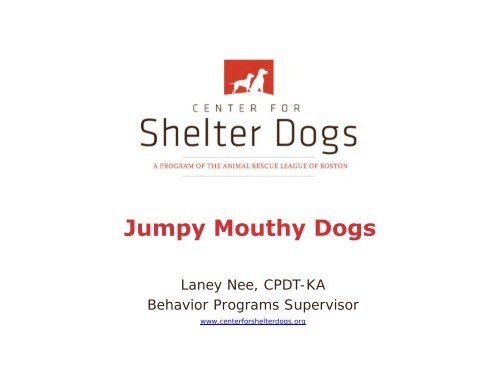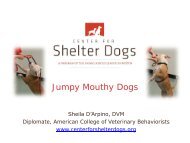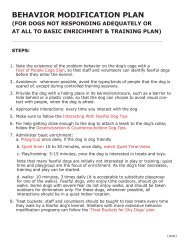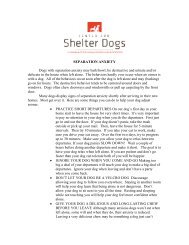Jumpy Mouthy Dogs - Center for Shelter Dogs
Jumpy Mouthy Dogs - Center for Shelter Dogs
Jumpy Mouthy Dogs - Center for Shelter Dogs
You also want an ePaper? Increase the reach of your titles
YUMPU automatically turns print PDFs into web optimized ePapers that Google loves.
<strong>Jumpy</strong> <strong>Mouthy</strong> <strong>Dogs</strong><br />
Laney Nee, CPDT-KA<br />
Behavior Programs Supervisor<br />
www.center<strong>for</strong>shelterdogs.org
Key Components of Successful <strong>Shelter</strong><br />
Behavior Programs<br />
Behavior Evaluation<br />
Assess & Provide<br />
Welfare<br />
Maximize & Improve<br />
Adoptability<br />
Find the Right<br />
Home!<br />
Post-adoption<br />
Follow-up
Goal of Behavior Modification Programs<br />
Assess risk<br />
Determine<br />
responsiveness<br />
to treatment<br />
Pets are usually<br />
NOT cured via<br />
behavior<br />
modification plans<br />
Determine type<br />
of adopter that<br />
is best <strong>for</strong> pet
Behavior Modification <strong>for</strong> Problem Behaviors<br />
Focus on<br />
effective<br />
management<br />
of problem<br />
behaviors<br />
Behavior<br />
modification<br />
begins with<br />
basic<br />
training and<br />
enrichment<br />
Create<br />
behavior plans<br />
<strong>for</strong> specific<br />
problems that<br />
your shelter<br />
has the<br />
capacity to<br />
treat
Use our <strong>Jumpy</strong> <strong>Mouthy</strong><br />
Problem Management Tool at<br />
www.center<strong>for</strong>shelterdogs.org
Myth of the <strong>Jumpy</strong> <strong>Mouthy</strong> Dog<br />
‘Dog who was NEVER trained?’
Reality of the <strong>Jumpy</strong> <strong>Mouthy</strong> Dog<br />
Dog who WAS trained…<br />
But techniques<br />
used didn’t<br />
work- resulted<br />
in increased<br />
frustration<br />
But stress of<br />
being in shelter<br />
and inadequate<br />
enrichment<br />
result in<br />
frustration<br />
But VERY high<br />
energy,<br />
impulsive dog,<br />
who has<br />
difficulty staying<br />
focused
<strong>Jumpy</strong> <strong>Mouthy</strong> <strong>Dogs</strong><br />
Dog with<br />
confident,<br />
playful<br />
personality<br />
Poor<br />
behavioral<br />
inhibition<br />
No intent<br />
to do<br />
harm
A ‘Typical’ <strong>Jumpy</strong> <strong>Mouthy</strong> Dog<br />
1.5 year mixed breed dog<br />
Very energetic<br />
Grabs onto leash and tugs<br />
Jumps on people<br />
<strong>Mouthy</strong> during play<br />
Some of these dogs are very<br />
mouthy, i.e. grab clothing and<br />
tug at it. Keeping staff and<br />
volunteers safe is crucial.
Pavlov/Eysenck’s Personality Model<br />
High Arousal/<br />
Good Inhibition<br />
Low Arousal/<br />
Good Inhibition<br />
High Arousal/<br />
Poor Inhibition<br />
Low Arousal/<br />
Poor Inhibition
When does JM Behavior Appear?<br />
Usually 48-72 hours after admission<br />
Less often at Day 0
Stimuli <strong>for</strong> the <strong>Jumpy</strong> <strong>Mouthy</strong> Behavior<br />
Any interaction with<br />
people<br />
Not enough interaction<br />
with people<br />
Stress of being in a<br />
shelter
Look at Stimuli <strong>for</strong> JM Behavior<br />
• Training equipment<br />
being put on/off?<br />
• Taking back to kennels?<br />
• Longer shelter stay?
Evaluation - <strong>Jumpy</strong> <strong>Mouthy</strong><br />
http://youtu.be/tuc6c6_pT1U
Training Plan <strong>for</strong> <strong>Jumpy</strong> <strong>Mouthy</strong> <strong>Dogs</strong><br />
REWARD<br />
CALM<br />
BEHAVIOR<br />
‘SAY<br />
PLEASE’<br />
PROGRAM<br />
RETRIEVE<br />
‘DROP IT’<br />
BASIC<br />
TRAINING<br />
CRATE<br />
TRAINING<br />
QUIET<br />
TIME
Working with <strong>Jumpy</strong> <strong>Mouthy</strong> <strong>Dogs</strong><br />
• Always have valuable<br />
treats and toys<br />
• Ask <strong>for</strong> good behavior<br />
be<strong>for</strong>e unwanted<br />
behavior occurs
The Plan<br />
Initial training with experienced/trained staff<br />
and volunteers ONLY
JM Training Session<br />
Task (15-30 minutes total)<br />
Time<br />
(minutes)<br />
Repeat<br />
Ignore JM bhr and reward calm bhr 2 to 3<br />
Play/Train<br />
1 to 2/ 1 to 2 2 to 3 times<br />
Ignore JM bhr and reward calm bhr 1 to 2<br />
Play/Train 1 to 2/1<br />
Crate training 2 to 3<br />
Quiet time 5 to 10
‘Say Please’ Program<br />
Lack of control of any<br />
aspect of their<br />
environment is very<br />
stressful to many<br />
dogs.<br />
‘Say Please’ introduces:<br />
CONSISTENCY<br />
CONTROL<br />
STRUCTURE
All of our program handouts<br />
are available on our website at<br />
www.center<strong>for</strong>shelterdogs.org
‘Say Please’ Program<br />
http://youtu.be/xlp34i193Pc
Play with People<br />
Retrieve<br />
Tug<br />
Drop It
Play with People<br />
http://youtu.be/ZWiRpUja_fc
Playing the Chase Game<br />
http://youtu.be/lezv_8J2SbQ
Playing with <strong>Dogs</strong>- Playgroups
Quiet Time<br />
http://youtu.be/wxkeZM44Ts8
APDT’s C.L.A.S.S. ®<br />
<strong>Dogs</strong> & Volunteers are<br />
tiered green, blue, red<br />
Volunteers work on<br />
C.L.A.S.S. with dogs<br />
tiered at their approved<br />
level
C.L.A.S.S. ®<br />
Successfully completing an evaluation after<br />
6 lesson plans earns a dog a Bachelor’s<br />
degree in C.L.A.S.S.
Gentle Leader Head Collar
Treatment Duration/Other Considerations<br />
Most dogs respond within 1-2<br />
days<br />
Continued treatment while in<br />
the shelter is crucial<br />
High likelihood of recurrence if<br />
treatment plan isn’t continued<br />
– or with long shelter stays<br />
These dogs are often more likely to<br />
be returned than those with many<br />
other more serious behavior<br />
problems.
Record Your Interaction!
Using Aversives <strong>for</strong> Undesirable Behavior<br />
Sometimes work, otherwise people<br />
wouldn’t use them<br />
May CAUSE anxiety and fear associated<br />
with person administering aversive.<br />
Some dogs do not respond to aversive<br />
and might even respond to aversive<br />
with aggression
Aversives <strong>for</strong> Inappropriate Behavior<br />
Generally not recommended…<br />
Spray bottle<br />
Shaker Can<br />
Citronella spray (SprayShield)<br />
Stern voice<br />
Remember that some dogs are<br />
VERY sensitive to aversives<br />
and that if they are ever used,<br />
they must be used rarely,<br />
judiciously and appropriately.
Adoption<br />
The right home is crucial:<br />
• Active people<br />
• People who enjoy<br />
training dogs<br />
• People who are willing<br />
to invest time, energy,<br />
and ef<strong>for</strong>t
Post adoption support and follow-up<br />
• Free counseling/training appointments<br />
• Phone calls and emails<br />
• Adopter knows that we are ‘on their<br />
team’
Next Webinar - 1/16 at 2pm EST!<br />
SAVING LIVES WITH<br />
BEHAVIOR PROGRAMS<br />
Free Webinar 1/16<br />
at 2pm<br />
Presented by Dr. Sheila<br />
D’Arpino, Veterinary<br />
Behaviorist at the<br />
<strong>Center</strong> <strong>for</strong> <strong>Shelter</strong> <strong>Dogs</strong><br />
Register Now!<br />
http://www.center<strong>for</strong>shelterdogs.com/Home/ResearchandEducation/Webinars.aspx
Questions?<br />
Laney Nee, CPDT-KA<br />
lnee@arlboston.org<br />
Thank You!!










